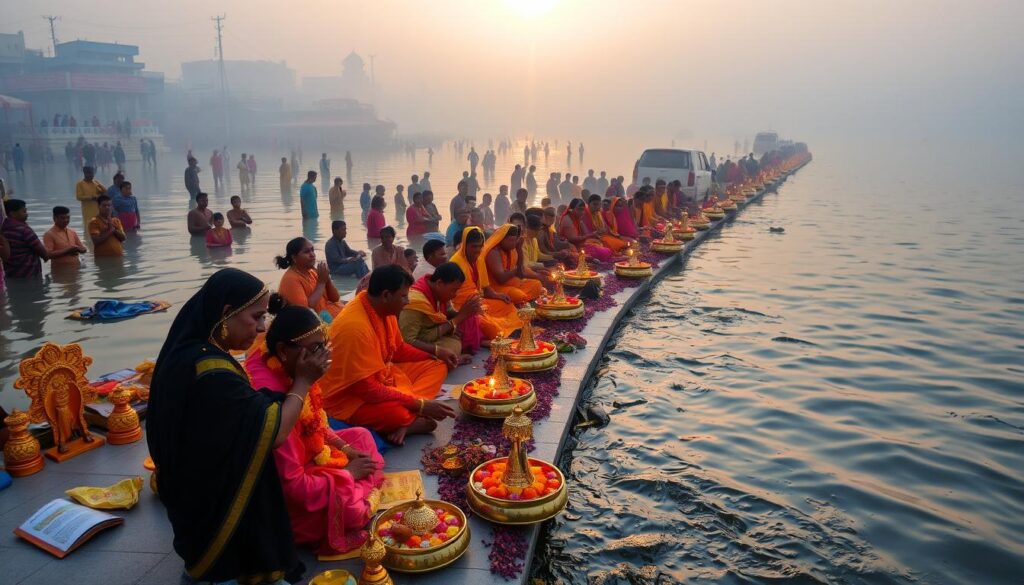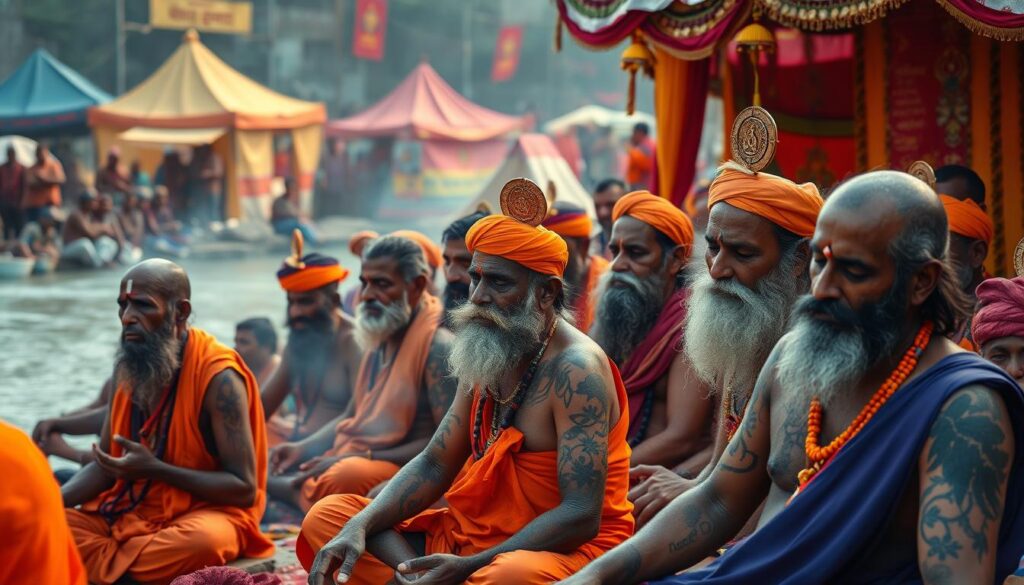The Mahakumbh Pilgrimage is a big event in Hinduism. It draws millions of people from all over the world. This spiritual gathering is the largest pilgrimage in the world.
It’s a chance for people to come together, share their faith, and feel the divine. The mahakumbh shows the richness and diversity of Hindu culture and spirituality.
The mahakumbh is a celebration of faith, spirituality, and culture. It’s an experience you won’t forget. Devotees can reconnect with their faith and see the beauty of Hindu culture.
The mahakumbh is special because it offers a chance for spiritual growth and self-reflection. It’s a way to dive deep into Hindu culture and spirituality.
Key Takeaways
- The Mahakumbh Pilgrimage is the world’s largest spiritual gathering, attracting millions of devotees from around the world.
- This pilgrimage is a celebration of faith, spirituality, and cultural heritage.
- The mahakumbh offers a unique opportunity for devotees to come together, share their faith, and experience the divine.
- The mahakumbh pilgrimage is a time for spiritual growth, self-reflection, and cultural immersion.
- The mahakumbh is a captivating and awe-inspiring experience that showcases the richness and diversity of Hindu culture and spirituality.
- The mahakumbh pilgrimage is a significant event in Hinduism, and is considered a once-in-a-lifetime experience for many devotees.
Understanding the Sacred Mahakumbh Festival
The Mahakumbh Festival is a big hindu festival. It shows the heart of spirituality and cultural heritage. It happens every 12 years in four sacred places, drawing millions from all over.
It’s a time for deep thinking, finding oneself, and starting anew. Devotees come to find their inner peace and seek enlightenment. The festival is full of music, dance, and art, showing India’s rich culture.
- The sacred ritual of the royal bath, where devotees take a dip in the holy river to cleanse their souls
- The ceremonial processions, where sadhus and saints parade through the streets, spreading messages of love and peace
- The evening aarti ceremonies, where devotees gather to sing hymns and prayers, filling the air with spiritual energy
The Divine Origins of Mahakumbh
The Mahakumbh Festival comes from Hindu myths. It tells of gods and demons trying to get the nectar of immortality. This story shows the fight between good and evil and our eternal search for spiritual growth.
The Historical Journey Through Centuries
The Mahakumbh Pilgrimage has a long history, dating back to the 7th century. This ancient indian festival has been celebrated for over 2,000 years. Each era has left its mark on the event.
From ancient Hindu scriptures to today’s celebrations, the Mahakumbh Pilgrimage is a big part of indian culture and tradition.
Some key highlights of the festival’s history include:
- 7th century: The first recorded mention of the Mahakumbh Pilgrimage
- 12th century: The festival becomes a major event in india, attracting pilgrims from all over the country
- 16th century: The Mughal Empire plays a significant role in shaping the festival’s tradition and culture

The Mahakumbh Pilgrimage has changed over the years, influenced by many traditions and cultures. Today, it’s a lively celebration of indian heritage. Millions of pilgrims and tourists come to experience it.
| Century | Event | Impact on indian culture |
|---|---|---|
| 7th | First recorded mention of the Mahakumbh Pilgrimage | Establishment of the festival as a significant event in indian tradition |
| 12th | The festival becomes a major event in india | Increased participation and influence on indian culture |
| 16th | The Mughal Empire shapes the festival’s tradition and culture | Introduction of new customs and practices that enrich indian tradition |
Sacred Rituals and Spiritual Practices
The Mahakumbh Pilgrimage is filled with sacred rituals and spiritual practices. People from all over the world join in. They believe these rituals bring spiritual enlightenment and inner peace.
One key ritual is the Royal Bath, or Shahi Snan. Devotees take a dip in the sacred river. It’s believed to cleanse their souls.
Some important spiritual practices and rituals include:
- The Royal Bath (Shahi Snan)
- Ceremonial Processions (Peshwai)
- Evening Aarti Ceremonies
These rituals are crucial to the festival. They help devotees reach their spiritual goals. The Shahi Snan is especially significant. It’s thought to have purifying powers.

By joining in these rituals, devotees can grow spiritually. The Mahakumbh Pilgrimage is a special time. It lets devotees celebrate their faith together.
| Spiritual Practice | Description |
|---|---|
| Shahi Snan | A ritual where devotees take a dip in the sacred river to cleanse their souls |
| Ceremonial Processions | A spectacular sight, with sadhus and saints marching through the streets, accompanied by music and chanting |
| Evening Aarti Ceremonies | A beautiful way to end the day, with devotees gathering on the riverbanks to pray and sing hymns |
Meeting the Holy Men: Saints and Sadhus
The Mahakumbh Pilgrimage is a special chance to meet holy men. These include saints and sadhus. They have spent their lives seeking spiritual knowledge and self-realization. They live by the principles of hindu spirituality.
Meeting these holy men offers many benefits. You can:
- Learn about their spiritual practices and experiences
- Get wisdom and guidance on growing spiritually
- Be inspired by their devotion and faith
When you talk to these sadhus and saints, you’ll learn more about hindu spirituality. This can change your life. It lets you connect with others and see life in a new way.

This chance to meet holy men is a great opportunity. It helps you understand the spiritual traditions of the Mahakumbh Pilgrimage. Meeting them will surely be a memorable part of your journey. It will touch your heart and mind deeply.
The Spiritual Geography of Mahakumbh
The Mahakumbh Pilgrimage is set in a special spiritual geography. It has a rich history and mythology. Millions of devotees come to its sacred sites.
This journey is through a landscape of faith. Here, nature and the divine meet. The sacred confluences are at the heart. These are where rivers meet, symbolizing spiritual renewal.
Some key features of this spiritual landscape include:
- Sacred confluences, where the rivers meet and create a potent symbol of spiritual renewal
- Important temples and shrines, such as the Kumbh Temple and the Akshaya Vat, which are significant pilgrimage sites
- Meditation spots and ashrams, which provide a peaceful retreat for spiritual seekers

Exploring the Sacred Sites
The spiritual geography of Mahakumbh is full of sacred sites. Each has its own energy and significance. From bustling temples to serene meditation spots, there’s something for everyone.
Whether you want to deepen your faith, find peace, or experience India’s spiritual heritage, Mahakumbh is unforgettable. It will transform and inspire you.
Planning Your Mahakumbh Pilgrimage
Planning your pilgrimage is key for a smooth trip. The Mahakumbh Pilgrimage draws millions. With good mahakumbh tips, your journey will be better. A detailed travel guide helps with the festival, places to stay, and how to get around.
To plan well, think about these steps:
- Book your stay early to avoid trouble
- Know the festival schedule and plan your days
- Look into travel options and book ahead
- Keep safe and be aware of your area
A good plan lets you enjoy the festival’s spiritual side. With the right mahakumbh tips and a good travel guide, your trip will be easy and rewarding.
Follow these tips for a safe and fun Mahakumbh Pilgrimage. Be ready to change plans and ask for help when needed. With careful planning and a reliable travel guide, your Mahakumbh experience will be unforgettable.
Accommodation and Facilities
The Mahakumbh Pilgrimage has many places to stay, from tent cities to hotels. There’s something for everyone. The festival is safe, with CCTV cameras and first aid.
Some key features of the accommodation options include:
- Comfortable and clean living quarters
- Access to modern amenities, such as toilets and showers
- Proximity to the festival grounds and sacred sites
Tent Cities and Camps
The tent cities and camps are loved by many. They offer a unique experience. These places have basic needs and a sense of community.
Modern Amenities
There are also modern places to stay, like hotels. They have services like food and laundry. These places meet the needs of those who want more.
The Mahakumbh Pilgrimage has many facilities and accommodation options. It ensures a comfortable and enjoyable stay for all.
Cultural Impact and Global Recognition
The Mahakumbh Pilgrimage has a big cultural impact worldwide. It’s not just in India. People from all over the world come to join in. UNESCO even calls it an Intangible Cultural Heritage of Humanity.
This festival brings people together. It shows unity and understanding across different cultures. It also boosts tourism in India. And UNESCO helps keep this cultural treasure alive.
- It keeps traditional practices and customs alive.
- It helps people from different cultures understand each other.
- It helps local economies by attracting tourists.
The festival’s fame has made people more aware of cultural heritage. UNESCO is key in protecting these important events.
Environmental Initiatives and Sustainable Practices
The Mahakumbh Pilgrimage has made big steps to lessen its environmental impact. It has started many environmental initiatives and sustainable practices. The festival aims to be cleaner and greener for everyone.
Some of the key initiatives include:
- Implementing waste management systems to reduce waste and promote recycling
- Conserving water and reducing plastic usage through river conservation efforts
- Utilizing green technology, such as solar power and biogas, to reduce the festival’s carbon footprint
These efforts show the festival’s dedication to sustainable practices and environmental initiatives. It’s a great example for other big events. By using green technology and encouraging eco-friendly actions, the Mahakumbh Pilgrimage is lowering its environmental harm. It’s also teaching people why sustainability is key.
As the festival grows, it’s vital to keep focusing on environmental initiatives and sustainable practices. This ensures a good impact on the environment and the community. Together, we can build a sustainable future for all.
| Initiative | Impact |
|---|---|
| Waste Management Systems | Reduced waste by 30% |
| River Conservation Efforts | Conserved 50% of water usage |
| Green Technology Implementation | Reduced carbon footprint by 25% |
Photography and Documentation Guidelines
When you go to the Mahakumbh Pilgrimage, knowing the photography guidelines is key. The festival has rules for media coverage. This includes getting media passes and permits for photos.
To really get the pilgrimage’s spirit, follow these steps:
- Get the right permits and media passes for photography and documentation
- Be respectful of the pilgrims and sadhus’ privacy
- Stick to the paths and areas set for media coverage
Following these rules helps keep the event sacred. It also lets you capture its beauty and importance. The Mahakumbh Pilgrimage is a chance to see India’s rich culture. Taking photos responsibly helps share this with everyone.
Conclusion: Embracing the Divine Experience
As the Mahakumbh Pilgrimage ends, we think about the deep spiritual growth and divine experience it gave us. This once-in-a-lifetime event brought people together. They shared their faith and took part in sacred rituals.
We learned a lot about the rich history and cultural significance of the Mahakumbh. We saw saints, sadhus, and seekers meet at sacred confluences. This experience changed lives, giving pilgrims a new sense of purpose.
We hope you’ll experience the divine experience of the Mahakumbh Pilgrimage. It’s a chance to find faith, community, and spiritual fulfillment. This event shows the lasting power of faith and community.
